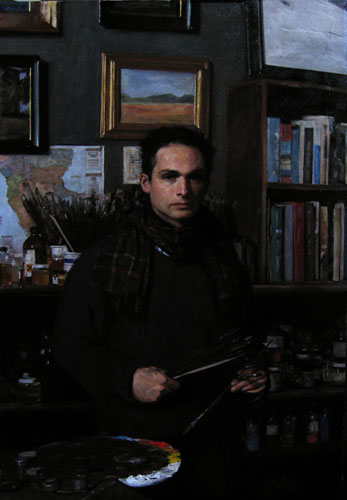
(Marc Dalessio) Self Portrait 2003
I recently discovered the website and blog of Marc Dalessio, an amazing landscape painter in a naturalistic style. He currently teaches at the Florence Academy of Art as the landscape painting instructor and also is a noted portrait painter. Marc works from his studio in Florence, Italy but also ventures on painting expeditions to various spots around the world including a recent venture to Myanmar. He post fascinating descriptions of his travels in Myanmar on his blog here. He has a few posts on this topic so hunt around his blog and website to get all the articles. His blog has lots of useful and engaging material – well worth investigating. You can also see more of his work on his Grenning Gallery website here.
I was curious to find out more about him and asked if he would be interested in doing an interview, I was thrilled that he took the time out from his busy schedule to agree to this interview.
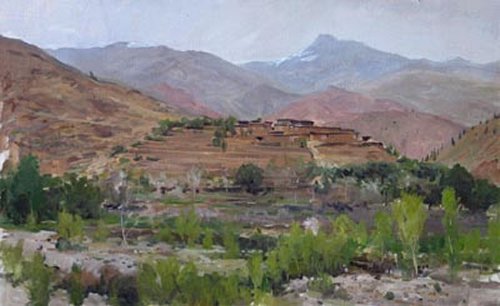
Atlas Mountain Village Oil on Canvas 2004 20 x 32 inches
Larry: You studied fine art as undergrad at University of California at Santa
Cruz, what lead you to Florence, Italy to train at the Charles Cecil
Atelier? How do you compare these two approaches to learning how to paint.
Marc:
I started at UCSC studying biology, assuming that I had just been born
in the wrong century for naturalistic painting. I was fortunate to
have two excellent teachers, Hardy Hanson and Patrick Aherne who gave
me a taste for what I really wanted to do. Then, in my senior year, I
did a year abroad program in Europe to see if I could find someone to
teach me there, assuming that the last home of great realist painting
would still have people around teaching. I stumbled upon Cecil studios
by accident and ended up staying in Florence for 17 years.
The main difference between a university art course and an atelier
training is that the university wants you to learn a little bit about
a lot of different subjects and study under various teachers with very
different ideas on art, whereas an atelier teaches you how to one
thing very well. I don’t know of any university which has the kind of
rigorous drawing course required to learn to be a proficient
draftsman. A good atelier will have at least a year-long intensive
drawing course with 4 week (or more) poses. In my opinion, for
traditional painting, the atelier system is a much stronger program.
Larry: Charles Cecil Atelier seems to advocate the Sight-size Technique in a
major way – is this something important in your current work and is it
something you use in landscape as well as portraiture?
Marc:
I use sight size almost all the time. Even when sketching. I find it
incredibly useful for portraits, obviously, but I have also developed
a way to use it for landscape painting where I pretty much don’t have
to worry about proportions and shapes while I’m painting. It allows me
to focus on everything else.
Larry: Looking at your work I imagine Velequez, Sargent, Corot and other
Masters of the past must influence you. Who are some contemporary painters
who influence your work and how?
Marc:
I think Corot, Sisley, and above all Isaac Levitan influenced my
outdoor work the most. Velasquez, Van Dyck and Sargent my portraits.
Living in Europe I feel actually out of the loop as far as
contemporary painters go. We only really have Antonio Lopez Garcia.
When I get back to America or browse around online I’m always inspired
by how many great contemporary realists there are working in America
today.
Keeping my list to painters whose work I’ve seen in person,
contemporary landscape painters I like are Joe Paquet, my friend Ben
Fenske, Donald Jurney, Joseph McGurl and Charles Cecil. For figurative
work I like Richard Maury, Elena Arcangeli, Jeremy Lipking, and
Graydon Parrish. As for how they influence me, I would say mostly in a
technical sense (their colors, edges, values… paint handling…
etc), never really for the subject matter.
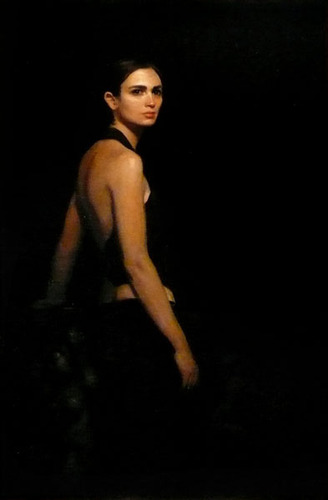
Ingrid Lamminpää oil on canvas 59 x 39 inches 2005
Larry: You draw and paint both the figure and the landscape extremely well.
Many painters usually only excel at one or the other yet you do both. Is
this from your intense study in observing nature? Some of your landscapes
are quite large, do you work on them all on site or from studies and or
photos?
Marc:
My figure work is actually not very good, without being modest. I can
get away with portraits because I painted so many while I was a
student at Cecil studios. For every good figure painting of mine, I’ve
probably destroyed 5 others.
I’ve always tried to push the limits of my canvas sizes outside and
have managed to paint canvases up to 60 x 40 inches outdoors. In the
winters I also blow up paintings from sketches. Lately I’ve tried
using a projector to have access to more information than I can get
from the sketch, but I try to use photographs as little as possible
and I never enlarge paintings that I haven’t already painted a sketch
of.
Larry: Any particular palette of colors that you tend to use? The tones in your
painting are very naturalistic and closely observed – what can you say about
color in your work that would be of note?
Marc:
I use a very limited palette of nine colors and, as such, I need to be
very exact with each. I grind about half of my colors myself. I also
use mostly very high chroma colors (three cadmiums). My flesh palette
is just red, yellow, black and white.

Candy. Oil on linen, 60 x 50 inches, 2008
Larry: Your portraits of the young women like Candy, Ingrid and the Serbian
Girl are stunning. They have an old-world masterly confidence but don’t seem
showy or academic. They seem honest, direct and not formula driven. I can
imagine these women as individuals; solid, powerful and very sensual women.
Many of your portraits appeal as a great painting in its own right, that you
paid them to model for you rather than them paying you to paint their
portraits. Ever consider composing painting with multiple figures, perhaps
with some sort of narrative?
Marc:
The portraits you describe actually are all of friends or paid models.
As for multi-figure compositions, I’ve never really been interested in
storytelling in painting. I was born in Hollywood and grew up in L.A,
and I’ve always thought if I had wanted to tell stories I would have
gone into film making. For me, art should capture a moment, a certain
mood or feeling.
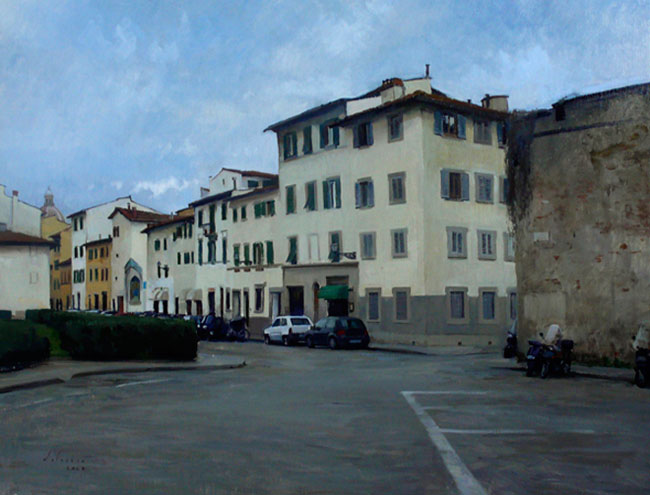
Piazza Tasso in February. Oil on linen, 27 x 39 inches, 2008
Larry: Many plein air painters avoid painting contemporary architecture and
modern life in general – perhaps looking for the picturesque or longing for
pastoral scenes before strip malls ravaged the landscape. You seem to avoid
the picturesque and present commonplace scenes where you live, like your
painting Plazza Tasso in February, 2008. The focus here appears more on the
formal aspects of your selection, the division of space, rhyme of shapes,
color harmonies, etc rather than simply reporting some wonderful view you
found. What do you think about when selecting the view you paint?
Marc:
I think for a long time I did try to stick to only picturesque views.
Especially living in Italy and after finishing Cecil studios where the
superiority of all things 17th century was hammered into me. After a
while though, it did seem false and I was very inspired by some
contemporary realists, especially Antonio Lopez Garcia, and decided to
try to look for more modern subjects. Also, after years of looking for
inspiring things to paint I’ve gotten good at it. Now I see beauty
everywhere, so I try to paint a range of subjects, from the
traditionally picturesque to more modern fare.
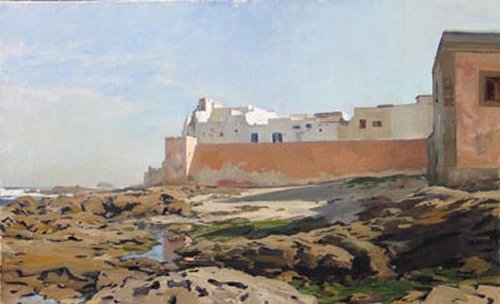
Essaouria from the Rocks oil on canvas 2004 20 x 32 inches
Larry: You teach Plein Air at the Florence Academy. I imagine you must teach on
a more advanced level. What would you say are the most common problems that
interfere with students painting the landscape. Anything you want to say to
someone considering study with you?
Marc:
I teach the advanced and intermediate students at the Florence Academy
and often the ones with less painting experience do better outside for
the first time. The advanced students assume if they can paint well in
the studio it will translate into strong painting outdoors, but
landscape painting is a very different beast. I would suggest to
anyone interested in landscape painting that they don’t put it off too
long. The earlier you start the less difficult it is.





Nice interview and very highly accomplished painting – thanks!
Great interview and highly accomplished painting! The beauty of well done paintings of Italian architecture is the timelessness of it. A sketch done by Thomas Jones in the 18th century looks as fresh as if it were done last week.
This is a wonderful interview. Two things I find fascinating about his work (especially shown in the portraits) is his use of black and the way he finishes one area, then works his way out to the edges of the picture.
His work is magnificent, so realistic and dramatic beyond perception. Love the post, just like the rest of your content. Joining your rss feed right away!
Cheers from London,
thanks. look forward to hearing more from you.
Wonderful interview, thank you so much. I subscribed to both your blog and his also. Very inspiring.
dear marc,you have very realitic art and my paintings very diffrent from yours,
so I want to try and learn to work looklike your..
metin ..
turkey-izmir
I was happy to hear the instructors that helped you, Hardy Hanson and Patrick Aherne from UCSC. I too studied with them and received such good instruction. In face Patrick suggested that I go to the NYSS on W. 8th st. in the NYC after graduating from UCSC. I don’t know if you heard the sad news of Hardy passing in January of this year. He helped me especially in doing a whole show of self- portraits for my finally year. Your work is very good.
I appreciate the interview very much. Marc Dalessio is an artist I recently discovered accidentally online. However, in all his paintings I immediately sensed something which I was familiar with. That is, an honest expression of the artist’s innermost feelings about nature and humanity is deeply embedded in his landscapes. The interview reveals how his art has been strongly influenced by Russian master Issac Levitan. That explains. Thank you.
Marc, just found your site, I’m 68 and still learning how to paint better.
I found the russians and Bongant and Fechin Berberian and Richard Schmid and was trying to find realist painters. I like your portraits and your videos of you working. Thats helped me so much to see how real artist work and i’m humbled by the amt of work you do. Thanks a million for the site on Monet 1338 paintings. I have a new respect for him. I ‘ve never seen all his work, what a painter. I enjoyed your friend ben painting the road. I learned so much seeing how ya’ll work and how you lay out your rustic palettes. And that big portrait you did , no words can express my excitement to see this. Im back to painting tomorrow and will try more portraits and faces.
I should have learned all this in college but i was playboy and , i was the grass hopper and not the ant. anyway, i run across many painters who say don’t use black. ovanes Beberian said that you can get all the nature colors with black and i’m sure Monet used black for a while anyway.
Thank you for the info about the sketch boards and the brushes. I really like a lot of artists and they all teach a little different and have different methods. Some more skilled than others but i think your studio paintings are first rate thats an A plus in my book and your sketches are really great also. I’ve painted plein air but the wind is not my friend. i work out my garage.
Its in the nitetime here and i want to see all your videos and paintings. My heritage is french and German and scottish and irish and maybe native american. we have a lot of painters on the
german side. Thanks again for doing the blog. and having allyour paintings on the net.
I’ve learned so much from just looking at how painters work and i do love the Russian Realists.
ovanes berberian is russian and lives in Idaho and his students do blogs of how he teaches.
i’m trying to use his structure and method and i’m a big fan of anders Zorn limited palette.
Berberian says painting can be frustrating. I noticed monet did lots of studies. thanks again, i’ll go look at the map and see where coratia is. Mike L.